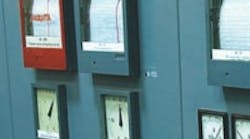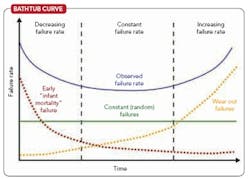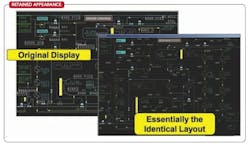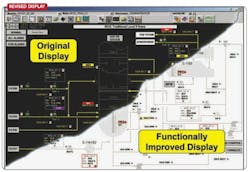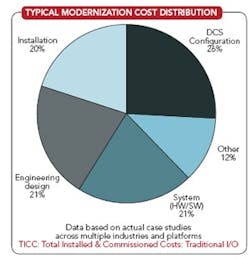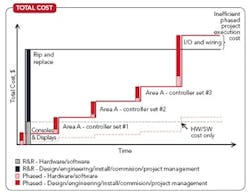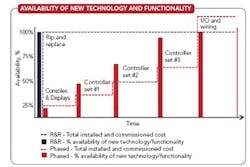Control Systems: Don’t Get Misled by Modernization Misconceptions
Many plants rely on control systems that are obsolete or on the verge of obsolescence. These systems can pose a variety of issues — from maintenance problems due to the difficulty and high cost of getting replacement parts to lack of features crucial for modern manufacturing — that can compromise the competitiveness of sites.
As with any major project, migrating to a new control system presents a number of challenges. The plant must cope with ongoing issues with the existing system and an environment during that transition that differs significantly from that during steady production, as well as the possibility of unpredictable events and funding difficulties. Moreover, the entire process can take quite a long time — years of planning followed by days, weeks or more for the actual switchover.
PREPARING FOR A MIGRATION
No big project can succeed without adequate preparation. Proper planning is critical for success. That planning must include identifying all the needs going forward as well as limitations in available staffing, funding and other resources. One of the most important parts of preparation is to understand common misconceptions about modernizations. These can undermine a migration project and, in the worst case, prevent it from delivering the fullest benefits. So, let’s dispel a number of such misconceptions.
Misconception No. 1: My current vendor is the best choice to be my future supplier because it knows my current system. This is false logic. Success depends mainly on knowledge of the new system, not the old. It’s better to know the destination than the starting point. For that reason, evaluate all suitable suppliers.
Misconception No. 4: Every vendor offers the same migration options. Not true. Vendors differ in their capabilities both in migration tools and expertise in areas like field instrumentation and control valves as well as in implementing fieldbus and wireless. It’s important to match the needs of the migration project to the capabilities of the candidate vendors.
Misconception No. 5: “One button” conversions eliminate coding concerns. Some people put great faith in a vendor’s promise of “one button” software conversions. The problem is that conversion tools are automated to various degrees and automated code conversion often can lead to errors and omissions.
On a more serious note, “as found” migrations that copy code from the legacy system will include a great deal of “dead code” — code that has been superceded by upgrades and other changes over the years but still exists in the system. A migration is an excellent opportunity to purge that dead code.
In addition, the converted legacy code doesn’t capitalize on advances in control technology over the past 20 to 30 years. Indeed, an end user at the modernization workshop at the 2012 ARC Forum advised that only about 70% of the legacy control strategy should be converted and warned: “Any more than that and you aren’t taking advantage of the new system capabilities.”
Misconception No. 6: A step-by-step (phased) migration is the lowest cost and lowest risk. This is a common belief — but not necessarily true. Many users, when estimating the cost of a modernization, envision the cost-versus-time graph shown in Figure 4. However, this graph only takes into account the system hardware and software costs. As Figure 5 indicates, these are a small portion of the total project costs. Figure 6 provides a more-realistic cost-versus-time graph once all the projects costs are quantified. It shows the total cost of the phased modernization actually is higher than the “rip and replace” due to the inefficiencies of multiple starts and stops with the project team and some duplication of engineering and effort to accommodate the multiple phases.
The rip-and-replace strategy front-loads the cost and incurs the risk all at once while a phased approach improves cash flow and spreads the risk into smaller portions. However, the total risk often is greater in a phased modernization because the older equipment remains in place longer, creating a greater probability of failures causing unplanned shutdowns.
Because of this, many projects evolve into an accelerated-phased approach — combining the replacement of consoles, all controllers and control networks into just one or two steps while delaying the significant cost of replacing the I/O and wiring until later. This provides more than 85% of the new technology benefits much sooner and at a lower cost than the multiple-phased strategy.
Table 3 summarizes the benefits and drawbacks of the rip-and-replace, accelerated-phased and extend-then-migrate approaches.
Most automation system vendors have found that many users initially plan for a multiphased migration that would take several years to complete, but after the process begins decide to compress it into fewer, faster phases. Once the initial fears of modernizing are overcome, the users realize the necessary personnel already are on-site and the knowledge base is in place, so they opt to accelerate everything, both to get the project over with and to more quickly gain the benefits of a more modern system.
Besides these misconceptions, modernization projects often raise a couple of misgivings:
Misgiving No. 1: Modernizations are risky and expensive. Many people believe this. To a large extent they are correct. Most things worth doing entail some risk or expense but there are ways to minimize the risk and maximize the rewards.
Misgiving No. 2: There’s no need to change. Some people simply refuse to change. They will continue to use an outdated system long past its anticipated useful life and won’t do anything until forced. Unlike those who delay migration until sufficient funds and resources are available, these people are determined to stick with the old no matter what happens. The former are a little late in gaining the advantages of new technology, the latter soon may be out of business and forgotten.
MAKE THE MOST OF A MODERNIZATION
Many of the misconceptions highlighted in this article focus on total cost, cash flow and risk. These obviously are important when planning your automation future. However, too often users don’t quantify and consider the benefits achievable from a modernization. The goal isn’t just to replace the existing system but to invest in tools that improve employee productivity and company profitability. Making modernization decisions without taking this into account often results in “lost opportunity costs.” For example, while extending the life of an existing system may seem attractive, upgrading to a new system sooner normally will generate a better return on investment by making available earlier tools that enhance performance in addressing business and regulatory challenges.
Today’s control systems offer more opportunity not only to take advantage of advanced control, asset diagnostics, wireless technologies, etc., but also to share data with business information systems and use the data to better coordinate the entire manufacturing process, including orders, scheduling, raw material management, actual production (the primary role of the automation system), maintenance, production planning, shipping (terminal management) and, in some cases, billing.
MIKE ALSUP is an automation business analyst for Emerson Process Management, Austin, Texas. E-mail him at [email protected].
